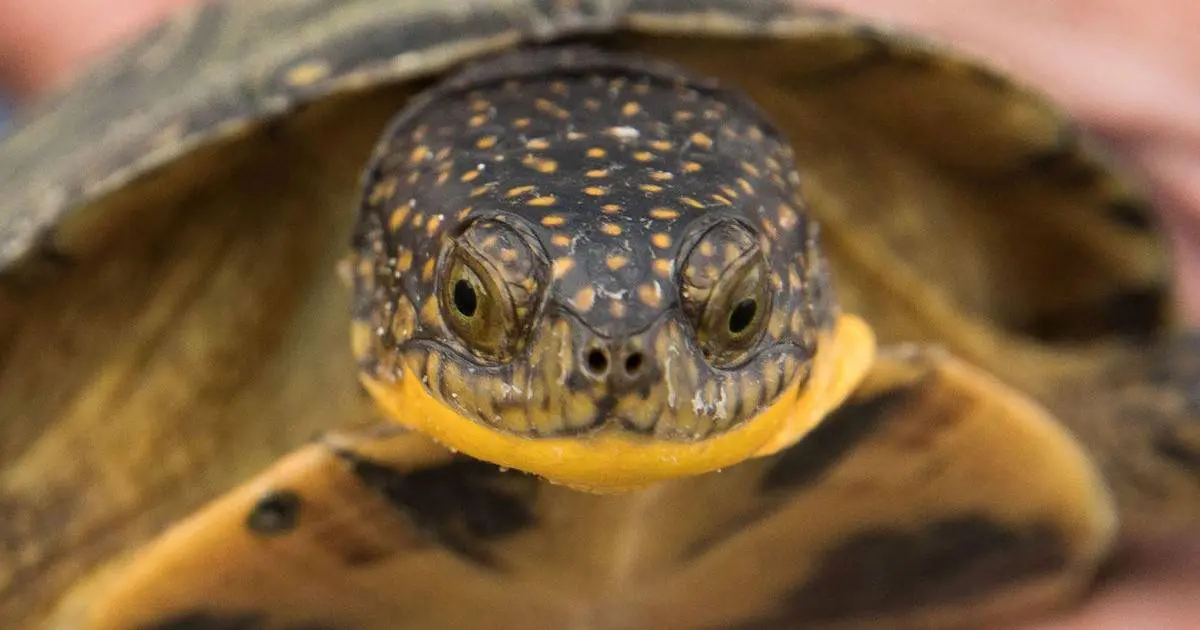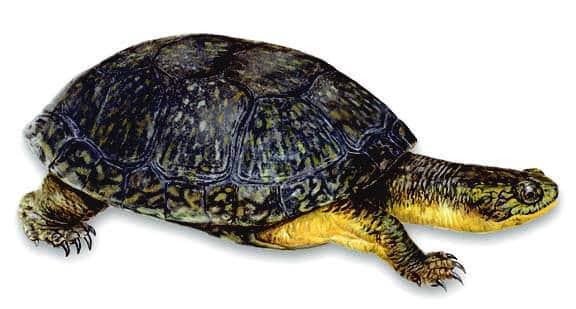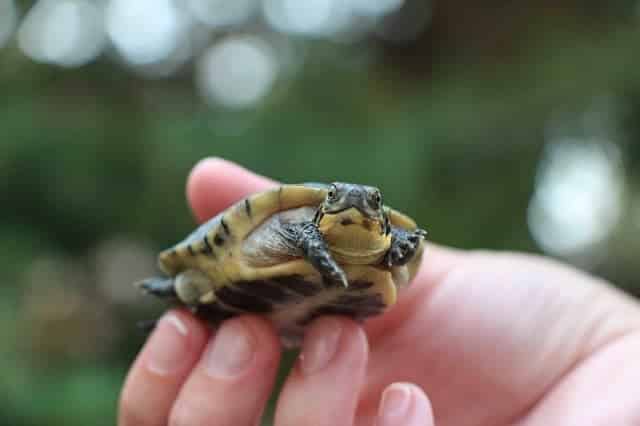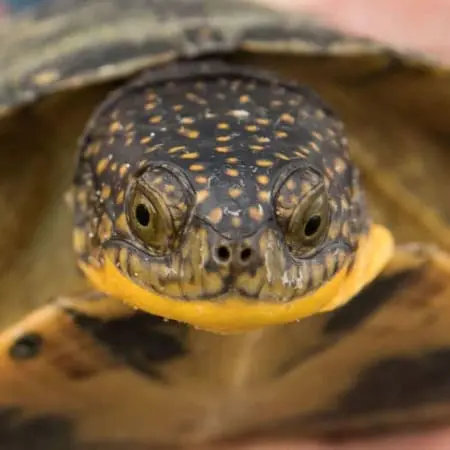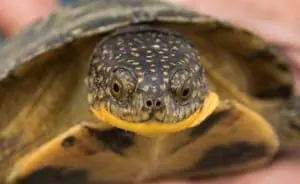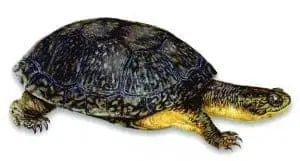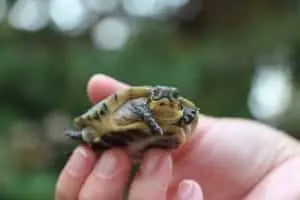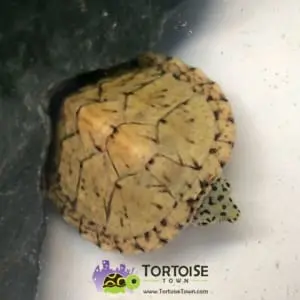Blanding’s turtle (Emydoidea blandingii)
Before purchasing a blanding’s tortoise for sale, be sure to learn proper blanding’s tortoise care including blanding’s tortoise diet, blanding’s tortoise habitat setup and more.
Known as “the turtle that smiles”, the Blanding’s turtle occurs in the northern most portions of the United States but also in Ontario and Nova Scotia. Disjunct populations in New York and New England are found while the main concentration of these turtles is located around the Great Lakes region. They are now listed under CITES ll and are considered threated or endangered in their native states. It is typically heavily protected and can no longer be legally exported. Road mortalities are this turtle’s biggest threat along with nest predation and over-collection for the black market pet trade. It is not legal to remove a Blanding’s turtle from the wild anywhere they occur. A cold hardy turtle, Blanding’s withstand harsh, long winters. Being subjected to these cold periods of dormancy allows them to successfully reproduce. It is highly recommended that these turtles be hibernated in captivity. Blanding’s turtles are medium to large sized as adults with males usually being a bit larger. A dark green to black carapace mottled with yellow spots, rays and flecks at a length of between 7 and 10 inches is typical. The carapace is also oval and features no flaring of the marginal scutes except in some males. The yellow plastron with a black blotch on each plate has a single hinge. This turtle is unique in having an extremely long neck much like a snake-neck turtle. They differ in that the head is not carried to the side but is held straight forward like other North American emydids. The head is somewhat flat with large “frog-like” eyes and the jaws reveal a big smile. The chin and throat are a bright yellow which can be spotted from a distance. The rest of the head and neck are dark with few if any markings. Sometimes, yellow flecks are found on the top of the head like on the carapace. The front limbs are dark with yellow scales and are equipped with large, sharp claws. Both the front and rear feet resemble those found on the box turtle which can sometimes confuse humans trying to identify them. The box turtle-like limbs and the hinged plastron make the Blanding’s turtle similar in appearance. Blanding’s however, cannot fully close up like the box turtle. Males exhibit a concave plastron, a longer, thicker tail a slight trapezoidal shape at times and may have a larger, broader head than females.
Emydoidea are found in highly vegetated, shallow water but are sometimes found in deep lakes. Farm ponds, wet meadows, marshes, bogs and even slow moving streams are inhabited. These turtles also move between bodies of water especially in the spring after hibernation, during nesting season and before hibernation in autumn. They are active from March until October with egg laying taking place in June. They hibernate under thick ice from November until March or April depending on the area. They are so cold tolerant that they can be seen slowly moving under the ice during the coldest of months.
Availability
Blanding’s turtles are not commonly available except in late summer-early fall when hatchlings have emerged. Adults are seldom seen for sale and fetch a very high price. Babies do well under captive conditions and may grow fast for the first 1 to 2 years before slowing down. The wild, this species can take up to 20 years to mature. In captivity this may happen much quicker but not as quickly as many other species. Beware of individuals offering Blanding’s turtles for sale in states where they are protected. This is an unfortunate and common practice which can lead to heavy fines or jail time as per the United States Fish and Wildlife Service. 100% legal and healthy Blanding’s hatchlings are available at Garden State Tortoise every fall. These babies are produced by our amazing adults, born right here.
Life Span
Emydoidea blandingii are known to be one of the longest lived of the turtles. In Michigan, studies taking place are showing that old adult turtles recorded in the 1970s are still producing fertile clutches of eggs today in 2013. Reports of turtles in their 80s and even 100s are not unheard of. They are highly adaptive and have voracious appetites.
Caging
Blanding’s should only be housed indoors while they are young. A 20 gallon long aquarium will suffice for 1 to 3 hatchlings. A 40 gallon breeder is even better and Rubbermaid totes prove to be excellent enclosures as well. They are also easy to clean. Once the turtles are at a less vulnerable size (4” SCL or more) they can be moved outdoors. We recommend an outdoor, in-ground pond. These turtles need both swimming room and walking room. They will take to land more than often where they will continue foraging for food unlike other semi-aquatic turtles. Nesting females also require a large land area to search for an appropriate site for oviposition. A 30×30 foot pen with a 15×15 water area in it will suffice for a small group of adults (1.3 or 2.4). The walls of the pen must be secure to keep the turtles in. This means, they should be at least 18” high and dug into the ground by about 6”. The walls can be made out of pressure treated wood, cement blocking, landscaping timbers and other fencing materials. These turtles can climb well so be sure to take appropriate measures in preventing escapes. The water area should be made of 45 to 65 mil fish friendly, pond liner and must be more than 18” deep. This is where the turtles will spend the winter so an adequate depth is crucial to avoid a solid freeze. Be sure to gradually slope the pond basin when digging it so that the turtles can easily get in and out of the water. The deepest part should be in the middle. Aquatic and land vegetation is an absolute must. Water hyacinth, water lettuce, lotus, various lilies, iris, cattails, frog bit and anacharis are all excellent choices for the pond itself. The turtles will greatly appreciate these items by hiding in them and searching for food. The land area can be planted with many different low lying shrubs, grasses and flowering plants. In the summer months, the turtles will leave the pond at times to hide under the foliage to escape the extreme heat and warming water. A gravel or sandy area should also be provided for the females to lay their eggs. This area should have little cover. Logs, drift wood or planking can be added to the water area as basking platforms. Avoid using too many rocks because they can be abrasive to the turtles’ plastrons. Filtration of the pond is optional. We prefer to use as many live plants as possible because they naturally filter the water. A peat based bottom is provided in which the plants are able to root in and grow. In combination with over flowing the pond bi-weekly, the plants help to keep the water in good condition.
Lighting, Temperature and Humidity
Natural sunlight is of course unbeatable and even baby Blanding’s turtles should receive at least some outdoor time in predator protected units. However, there are several lighting options for keeping them inside. Mercury vapor bulbs, daylight spot bulbs, infrared bulbs and fluorescent tube lights are all available to keepers today. We prefer Mercury vapor bulbs which provide both UVA and UVB to the turtles. 100-150 watt bulbs over a dry basking area of drift wood or cork bark do the trick. Do not use aquarium water heaters with Blanding’s turtles. They must be kept in cooler water no higher than 70-75F. They do not care for excess heat and temperatures can drop well into the low 60s and high 50s during the night with no additional heating requirements needed. The lights should be turned on in the morning and left on for 12 to 14 hours. It’s important to turn them off at night so that the turtles are exposed to a more natural, daily cycle like they would experience outdoors.
Substrate
Indoors, I prefer to not use any substrate simply because without it, the enclosures are much easier to clean. I especially like to do this because I do not use filters. Instead, I choose to do frequent water changes with Blanding’s turtles. If you would like to use a substrate, pea gravel is a good option. Outdoors, the pond area should have a 12-24” layer of peat and mud for the turtles to burrow into and for the plants to take root in. Allow leaves to collect in the pond during the fall because they will aid the turtles in hunkering down for hibernation.
Food
Emydoidea blandingii are vigorous feeders. They accept a wide variety of items and are very carnivorous. I have only once witnessed a specimen attempt to eat something that was not “meat”. This was a strawberry and perhaps the turtle thought it was meat because of the red coloration. Baby Blanding’s will accept any of the commercial turtle pellets available in time. Adults prefer fish, frogs, tadpoles, mice, beef heart, chicken parts, crayfish and other animal matter. We have success feeding our adults pinky mice (occasionally whole, adult mice), young bull and green frogs, beef heart, chicken hearts, gizzards and livers, smelt, silversides, tilapia, killies and frozen/thawed crayfish. We also offer them wet dog food but only brands that use whole/natural ingredients. Blandingii are comical and aggressive when feeding and will follow you around on sight in hopes that you have something for them!
Be careful to not over-feed. They will eat and eat and eat. They are known to stuff themselves to the point of regurgitation.
Temperament
This is an extremely responsive species. They will quickly associate their keepers as a food source which prompts an aggressive response. Our Blanding’s turtles will notice us from a distance and will actively move toward us. They will swim powerfully, climbing out of the water almost agilely to get to a potential food item. They learn to lose their fear of humans rather swiftly. They are a very rewarding turtle to work with to say the least.
Reproduction and Breeding
Like North American wood turtles, Blanding’s turtles have two peaks in breeding behavior. Early autumn and spring seem to hold the highest frequency of mating activity. Mating takes place in an aquatic setting and rarely occurs on land except for when the female hauls the male out of the water while he is latched onto her. The male will climb on top of the female and grasp the front end of her carapace with his strong claws. He then snakes his head downward in front of hers while moving it from side to side. If the female accepts, he will begin successful copulation with her. They may remain together, floating at the surface or fully submerged for some time. In late May, female Blanding’s turtles become restless, may accept less food or stop eating completely. As June sets in, they will pace relentlessly in search of a nesting site. On a warm night, many times after a rain shower or thunder storm, the females will usually select a spot to dig a nest. Nesting may commence between the hours of 6 and 9 pm but I have experienced even later attempts, sometimes as late as 12 am. Gravel based or sandy slopes and dunes are hotly contested as are dirt paths and roadways. As the sun goes down, the female Blanding’s turtle will use her hind legs to dig a flask shaped nest in the earth. She will deposit between 6 and up to 20 eggs in the nest before covering it up. She may use debris to help disguise the nest site from predators. The whole process can take more than two hours depending on the individual turtle. Once completed, she makes the dangerous trek back to her watery home. At Garden State Tortoise we artificially incubate our Blanding’s turtle eggs as with all species bred here. They are placed in deli cup containers on moistened vermiculite. The deli cups (with a few small air holes punched in them) are then put in an incubator set at between 84 and 86F. Emydoidea in our care tend to hatch rather fast at between 45 and 60 days. Upon hatching, the babies are left in the containers inside the incubators until they have fully absorbed their yolk sacs. They are then taken to their rearing enclosures where they begin normal daily routines and experience care in captivity. They may not accept food for up to 10 days after hatching.
-Information provided by Chris Leone of Garden State Tortoise LLC
If you are interested in a different species of baby tortoise for sale, or adult tortoise for sale, check out all of our tortoises for sale here. Searching for new baby turtles for sale? Be sure to check out our baby turtle for sale page!

